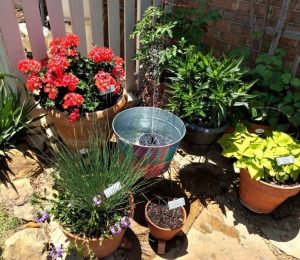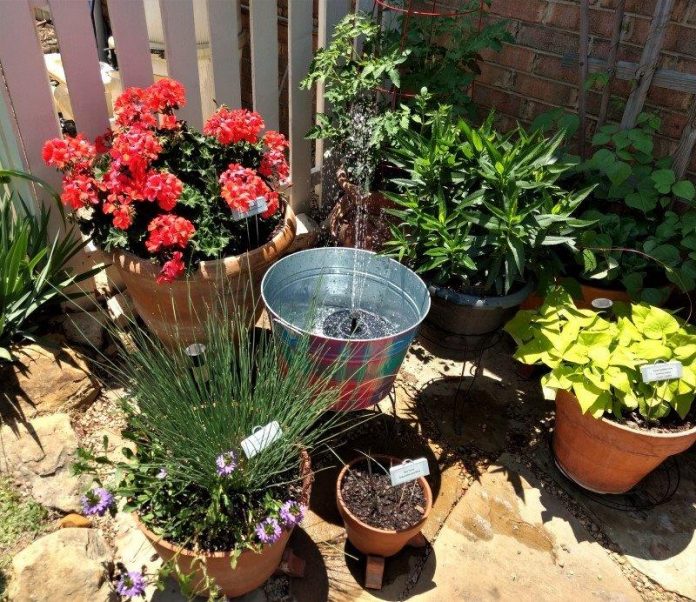
By Liz Moyer, Denton County Master Gardener Association
We love having containers of colorful plants around the patio for almost ten months of the year and bringing the more tender succulents inside for the winter. One challenge faced with all gardening, but perhaps most critical with containerized plants, is providing water in the right amounts, in the right way.
Smaller containers will dry out faster than larger ones. Hanging baskets will dry out faster than terra cotta or glazed pots. Mulch can be used in containers to reduce water loss, just as it does in our gardens. Not enough water and plants die, but excessive amounts of water can kill plants too. Plants require oxygen, which is absorbed from the soil through the roots. If there is too much water, all the little air pockets will be filled and the plant will drown.
So how do we assure our plants have just the right amount of water?
Before heading out to water, take a moment to think like a raindrop. If the soil in the pots is very dry or hard, the raindrop will just bounce off, providing no help to the poor thirsty plants. If the soil is already too wet, the raindrop will evaporate or just run off, possibly leaving salts behind (assuming our “raindrop” is coming from a water supply system).
Check to see if plants really need watering. Plants that look tired and wilted in the late afternoon and evening do not necessarily need water. Plants close their stomata (tiny openings between the surface cells that allow water to escape to cool the leaf surface) in the heat of the day to conserve water, and that results in a wilted look. If they look wilted first thing in the morning, it’s time to water!
If the soil is extremely dry, gently provide a little water to cover the surface and give it time to soak in before providing more. This wetting of the soil will soften it and make it more receptive to the deeper watering coming. It may be necessary to do this several times to soften the soil to a depth that water will be available to the roots. Watch to see if water is soaking in or just running off.
Be careful of leaving water standing on leaves. Some plants such as roses do not tolerate having wet leaves; fungus and disease are often triggered by standing water on the leaves. For these plants consider using a watering can with a long narrow spout that can reach in under the foliage to deliver water directly to the soil.
Water gently. If using a hose-end sprayer, choose a setting that most mimics a gentle rainfall. Give your plants a little head start with a light shower to soften the top of the soil before coming back around for the deep root watering. Try to picture the water soaking into the soil and estimate how deep it has gotten in the pot, or just gently water each container until water is coming out the hole in the bottom.
If your containers are not moved often, a drip irrigation system is definitely the best way to keep plants adequately watered. With emitters in each container and a timer, plants can be maintained with minimum effort. It is good practice to check periodically and be sure each one is getting the correct amount of water with these systems as emitters can clog, or the amount of water required may have changed due to weather or other conditions.
Containerized plants offer us a wonderful opportunity to bring a greater variety to our gardens, to fill in that one spot where nothing will grow, and just to have more of nature up close and personal in our outdoor living spaces. Watering them properly will keep them happy and healthy throughout the year, and in some cases, for years to come.
Reference:
Texas A&M AgriLife Extension Ornamental Production;
https://aggie-horticulture.tamu.edu/ornamental/greenhouse-management/irrigating-greenhouse-crops/
Texas A&M AgriLife Extension, Vegetable Gardening in Containers;
https://aggie-horticulture.tamu.edu/vegetable/files/2010/10/E-545_vegetable_gardening_containers.pdf



















